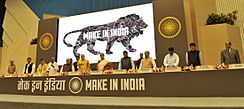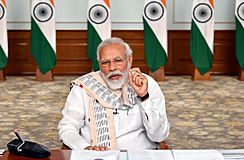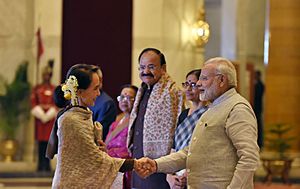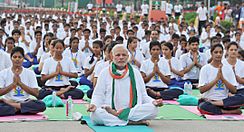Narendra Modi facts for kids
Quick facts for kids
Narendra Modi
|
|||||||||||||
|---|---|---|---|---|---|---|---|---|---|---|---|---|---|

Official portrait, 2023
|
|||||||||||||
| Prime Minister of India | |||||||||||||
| Assumed office 26 May 2014 |
|||||||||||||
| President | Pranab Mukherjee Ram Nath Kovind Droupadi Murmu |
||||||||||||
| Vice President | Mohammad Hamid Ansari Venkaiah Naidu Jagdeep Dhankhar |
||||||||||||
| Preceded by | Manmohan Singh | ||||||||||||
|
|||||||||||||
| Leader of the House, Lok Sabha | |||||||||||||
| Assumed office 26 May 2014 |
|||||||||||||
| Deputy | Gopinath Munde Sushma Swaraj Rajnath Singh Nitin Gadkari |
||||||||||||
| Speaker | Sumitra Mahajan Om Birla |
||||||||||||
| Preceded by | Sushilkumar Shinde | ||||||||||||
| Member of Parliament, Lok Sabha | |||||||||||||
| Assumed office 5 June 2014 |
|||||||||||||
| Preceded by | Murli Manohar Joshi | ||||||||||||
| Constituency | Varanasi, Uttar Pradesh | ||||||||||||
| Chief Minister of Gujarat | |||||||||||||
| In office 7 October 2001 – 22 May 2014 |
|||||||||||||
| Governor |
List
|
||||||||||||
| Preceded by | Keshubhai Patel | ||||||||||||
| Succeeded by | Anandiben Patel | ||||||||||||
| Member of Gujarat Legislative Assembly | |||||||||||||
| In office 15 December 2002 – 16 May 2014 |
|||||||||||||
| Preceded by | Kamlesh Patel | ||||||||||||
| Succeeded by | Suresh Patel | ||||||||||||
| Constituency | Maninagar | ||||||||||||
| In office 24 February 2002 – 19 July 2002 |
|||||||||||||
| Preceded by | Vajubhai Vala | ||||||||||||
| Succeeded by | Vajubhai Vala | ||||||||||||
| Constituency | Rajkot II | ||||||||||||
| General Secretary (Organisation) of the Bharatiya Janata Party | |||||||||||||
| In office 5 January 1998 – 7 October 2001 |
|||||||||||||
| Preceded by | Kushabhau Thakre | ||||||||||||
| Succeeded by | Sanjay Joshi | ||||||||||||
| Personal details | |||||||||||||
| Born |
Narendra Damodardas Modi
17 September 1950 Vadnagar, Bombay State, India (present-day Gujarat) |
||||||||||||
| Political party | Bharatiya Janata Party | ||||||||||||
| Spouse |
Jashodaben Modi
(m. 1968; sep 1971) |
||||||||||||
| Residence | 7, Lok Kalyan Marg, New Delhi | ||||||||||||
| Alma mater |
|
||||||||||||
| Awards | List of awards and honours | ||||||||||||
| Signature |  |
||||||||||||
Narendra Damodardas Modi (born 17 September 1950) is an Indian politician. He has been the 14th prime minister of India since May 26, 2014. He is the longest-serving prime minister who is not from the Indian National Congress party. In the 2024 general election, Modi's party did not win enough seats on its own. So, they formed a government with their allies, called the National Democratic Alliance (NDA).
Contents
Narendra Modi's Early Life and Education
Narendra Damodardas Modi was born on September 17, 1950. He grew up in Vadnagar in Gujarat. His family were grocers and followed the Hindu faith. He was the third of six children.
Modi finished his high school education in Vadnagar in 1967. His teachers said he was an average student. However, he was a very good debater and loved theatre. Playing big characters in plays later helped him in his political life.
When he was eight, Modi joined the Rashtriya Swayamsevak Sangh (RSS). This is a group that holds training sessions. There, he met Lakshmanrao Inamdar, who became his political guide. Modi also met other leaders who helped start the BJP party in Gujarat.
In 1978, Modi earned a Bachelor of Arts degree in political science from the University of Delhi. Later, in 1983, he received a Master of Arts degree in political science from Gujarat University. He studied these degrees through distance learning.
Narendra Modi's Early Political Career
In June 1975, Prime Minister Indira Gandhi declared a "state of emergency" in India. This lasted until 1977. During this time, many political opponents were jailed. Opposition groups were also banned. Modi was made a leader of a group that opposed the Emergency in Gujarat.
The RSS was banned, so Modi had to work secretly. He often traveled in disguise to avoid being arrested. He helped print leaflets against the government. He also organized protests and helped people who were wanted by the government find safe places.
Modi became the Chief Minister of Gujarat in 2001. This happened because the previous Chief Minister, Keshubhai Patel, was not well and faced public criticism after the earthquake in Bhuj. Modi was elected to the state assembly soon after. His time as Chief Minister included challenges and criticisms, especially regarding public safety during difficult times. While his policies were praised for helping the economy grow, his government was criticized for not doing enough to improve health, reduce poverty, or boost education in the state.
Narendra Modi as Prime Minister

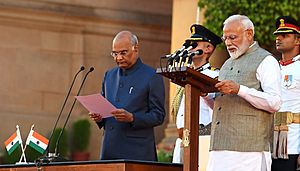
The Bharatiya Janata Party (BJP) and its allies, the National Democratic Alliance, won a huge victory in the 2014 election. Modi became the Prime Minister of India on May 26, 2014. He was the first Prime Minister born after India became independent from the British Empire in 1947.
Modi started his second term after his alliance won again in the 2019 election. By December 6, 2020, he became the 4th longest-serving Prime Minister of India. He is also the longest-serving Prime Minister not from the Indian National Congress party.
Key Government Initiatives

In his first year, Modi's government focused on centralizing power. He used special orders to pass policies because his party did not have a majority in the upper house of Parliament. The government also passed a law that gave it more control over choosing judges.
In December 2014, Modi replaced the old Planning Commission with a new body called NITI Aayog. This change gave more power to the Prime Minister. The old Planning Commission had been criticized for being inefficient.
The Modi government started investigations into some non-profit groups. They said these groups were slowing down economic growth. This led to some debate and concern. Some people who criticized the government also faced legal action.
Modi's government repealed many old laws. In his first three years, he removed 1,200 outdated laws. Previous governments had repealed only 1,301 such laws over 64 years. He also launched the Digital India program. This program aims to make government services available online. It also wants to bring high-speed internet to rural areas and boost electronics manufacturing.
In 2019, a law was passed to save 10% of spots in education and government jobs for people who are not well-off financially. In 2016, the government started the Ujjwala scheme. This program gives free cooking gas connections to families in rural areas. This helped many more households get access to cooking gas.
Economic Policies and Growth
Modi's economic policies focused on opening up the economy and allowing more private businesses. He made it easier for foreign companies to invest in India. This included areas like defense and railways. Some proposed changes to labor laws, which would make it harder for workers to form unions, were dropped after protests.
The government reduced money for programs that help reduce poverty and improve social welfare. Spending on health and family welfare also decreased. They lowered taxes for companies and removed the wealth tax. In October 2014, diesel prices were no longer controlled by the government.
In September 2014, Modi started the Make in India initiative. This program encourages foreign companies to make products in India. The goal is to make India a major manufacturing center. The government also introduced the Goods and Services Tax (GST). This was a big tax reform that combined about 17 different taxes. It started on July 1, 2017.
Modi's first cabinet decision was to set up a team to investigate "black money" (undeclared money). On November 9, 2016, the government stopped using ₹500 and ₹1000 banknotes. This was done to fight corruption, black money, fake money, and terrorism. This caused a shortage of cash and led to protests. However, it also led to more people filing income tax returns and more digital payments.
During Modi's first four years as Prime Minister, India's economy grew faster than before. However, the gap between rich and poor increased. A government report in 2017 said that unemployment was at its highest level in 45 years. This was linked to the banknote change and the new tax system. The economy shrank during the COVID-19 pandemic but was expected to grow again.
Health and Sanitation Efforts
In his first year, Modi's government reduced central government spending on healthcare. In January 2015, the Modi government launched a New Health Policy (NHP). This policy did not increase government spending on healthcare. Instead, it focused more on the role of private healthcare companies. This was a change from the previous government's focus on public health programs.
Modi emphasized his government's efforts to improve sanitation for better health. On October 2, 2014, Modi launched the Swachh Bharat Mission ("Clean India") campaign. One goal was to stop manual scavenging within five years. As part of this program, the government built millions of toilets in rural areas. They also planned to build new sewage treatment plants.
The number of homes with proper sanitation increased greatly. In 2018, the World Health Organization said that at least 180,000 deaths from diarrhea were prevented in rural India because of this sanitation effort.
When the COVID-19 pandemic started, Modi's government took action. They suspended flights and announced a nationwide lockdown. Restrictions were slowly lifted later. A second wave of the pandemic in 2021 was very severe. There were shortages of vaccines, hospital beds, and oxygen. India started its vaccination program in January 2021. By January 2022, India had given out about 1.7 billion vaccine doses.
Foreign Relations
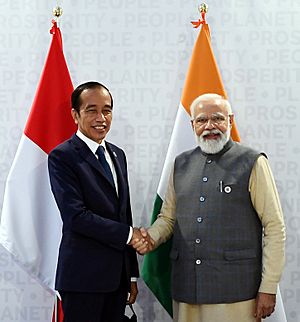
Foreign policy was not a main topic in Modi's election campaign. However, his foreign policy focused on improving economic ties, security, and relations with other countries in the region. Modi continued the previous government's policy of "multi-alignment." This means having good relations with many different countries.
The Modi government tried to attract foreign investment to India. They used slogans like "Make in India" and "Digital India". They also worked to improve relations with Middle Eastern countries like Bahrain, Iran, Saudi Arabia, and the United Arab Emirates, as well as with Israel.
India's relations with the USA also improved under Modi. Even though Modi had been denied a US visa in 2005, President Obama invited him to visit the US after he became Prime Minister. The Modi government built strong relations with the USA during both the Obama and Trump presidencies.
Modi visited many countries in his first few months as Prime Minister. He attended important meetings like the BRICS, ASEAN, and G20 summits. He promised a billion US dollars in aid to Nepal during one of his first visits.
In 2015, India and Bangladesh agreed on a land exchange deal. Modi's government also focused more on India's "Look East Policy," renaming it the "Act East Policy." This policy aims to improve relations with countries in East Asia and Southeast Asia. Relations between India and China have become more difficult after border clashes in 2020.
Defence and Security
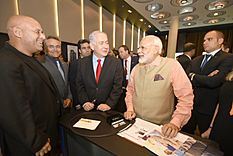
India's military spending increased under Modi. However, as a share of the country's economy, it decreased. A large part of the military budget goes to personnel costs. This limits how much India can spend on modernizing its military.
Modi promised to be "tough on Pakistan" during his election campaign. He often said that Pakistan was supporting terrorism. In February 2019, India carried out airstrikes in Pakistan against a suspected terrorist camp. This led to more military clashes and cross-border shelling.
After his victory in the 2019 election, Modi focused more on India's defense policies, especially against China and Pakistan. In May 2020, Chinese and Indian troops had clashes along the border. This led to more skirmishes and talks between the two countries.
In December 2021, Modi signed an agreement with Russian leader Vladimir Putin to continue military cooperation. The Modi government also bought the S-400 missile system from Russia. This anti-missile system helped build stronger ties between the two nations.
Environmental Policies
When Modi named his cabinet, he changed the name of the "Ministry of Environment and Forests" to include "Climate Change." In his first budget, the money for this ministry was cut by more than half. The new ministry also changed or weakened some laws related to environmental protection.
The government also tried to change the National Board for Wildlife so it would not have members from non-profit groups. However, the Supreme Court stopped this. Other changes included less government oversight on small mining projects. They also no longer required approval from tribal councils for projects in forested areas.
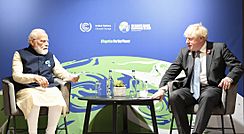
In 2014, Modi said that "Climate has not changed. We have changed." However, over the years, he has become a strong supporter of climate action. He especially supports using clean energy. In 2015, Modi proposed the International Solar Alliance. This initiative encourages investment in solar energy.
At the COP26 conference, Modi announced that India would aim to have "net zero" carbon emissions by 2070. India also plans to increase its renewable energy capacity. Environmental experts praised this decision. India is currently the only major economy on track to meet its Paris Agreement goals.
Public Image and Recognition
Modi has generally received high approval ratings during his time as Prime Minister. He is often seen as one of the greatest prime ministers in Indian history in public opinion polls.
Modi has appeared on the cover of Time Magazine several times. He was named "Indian of the Year" by CNN-News18 in 2014. Time magazine also listed him among the "100 Most Influential People in the World" in 2014, 2015, 2017, 2020, and 2021. Forbes Magazine ranked him as one of the "Most Powerful People in the World" several times.
In 2015, Fortune Magazine listed him among the "World's Greatest Leaders." In 2016, a wax statue of Modi was put on display at Madame Tussauds wax museum in London. He is also one of the most followed world leaders on social media platforms like Twitter, Facebook, and Instagram.
In October 2018, Modi received the United Nations' highest environmental award, the 'Champions of the Earth'. This was for his work in promoting the International Solar Alliance. He also received the 2018 Seoul Peace Prize. This award recognized his efforts to improve international cooperation and economic growth in India. He is the first Indian to win this award.
After his second swearing-in as Prime Minister, a picture of Modi was shown on the ADNOC building in Abu Dhabi, United Arab Emirates. In September 2019, he was honored at a large event in Houston, Texas, attended by over 50,000 people and President Donald Trump. He was given the "Key to the City" of Houston. He also received the Global Goalkeeper Award from the Bill & Melinda Gates Foundation for his work on the Swachh Bharat Mission.
In 2020, Modi received the parodic Ig Nobel Prize in Medical Education. In December 2020, President Donald Trump awarded Modi the Legion of Merit for improving relations between India and the United States. In February 2021, the largest cricket stadium in the world, in Ahmedabad, was renamed Narendra Modi Stadium.
In July 2024, Modi was given the Order of St. Andrew, Russia's highest civilian award. This was for his work in developing ties between India and Russia. In November 2024, he received the Grand Commander of the Order of the Niger (GCON) from Nigeria. This is one of Nigeria's highest honors. In December 2024, Modi was given the Order of Mubarak the Great, the highest national honor of Kuwait.
Electoral History
| Year | Office | Constituency | Party | Votes for Modi | % | Opponent | Party | Votes | % | Margin | Result | Ref | ||
|---|---|---|---|---|---|---|---|---|---|---|---|---|---|---|
| 2002^ | Member of the Legislative Assembly | Rajkot II | Bharatiya Janata Party | 45,298 | 57.32 | Ashwinbhai Narbheshankar Mehta | Indian National Congress | 30,570 | 38.68 | 14,728 | Won | |||
| 2002 | Maninagar | 113,589 | 73.29 | Yatinbhai Oza | 38,256 | 24.68 | 75,333 | Won | ||||||
| 2007 | 139,568 | 69.53 | Dinsha Patel | 52,407 | 26.11 | 87,161 | Won | |||||||
| 2012 | 120,470 | 75.38 | Shweta Sanjiv Bhat | 34,097 | 21.34 | 86,373 | Won | |||||||
| 2014 | Member of Parliament, Lok Sabha | Vadodara | 845,464 | 72.75 | Madhusudan Mistry | 275,336 | 23.69 | 570,128 | Won | |||||
| 2014 | Varanasi | 581,022 | 56.37 | Arvind Kejriwal | Aam Aadmi Party | 209,238 | 20.30 | 371,784 | Won | |||||
| 2019 | 674,664 | 63.62 | Shalini Yadav | Samajwadi Party | 195,159 | 18.40 | 479,505 | Won | ||||||
| 2024 | 612,970 | 54.24 | Ajay Rai | Indian National Congress | 460,457 | 40.74 | 152,513 | Won | ||||||
See also
 In Spanish: Narendra Modi para niños
In Spanish: Narendra Modi para niños




